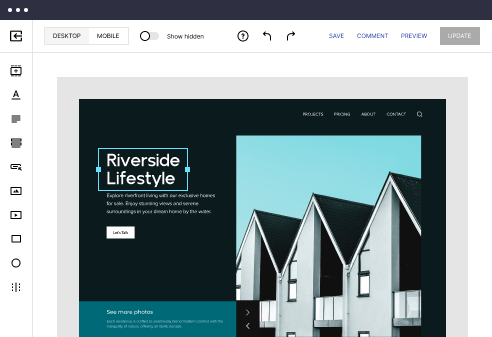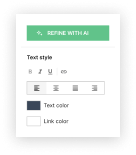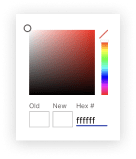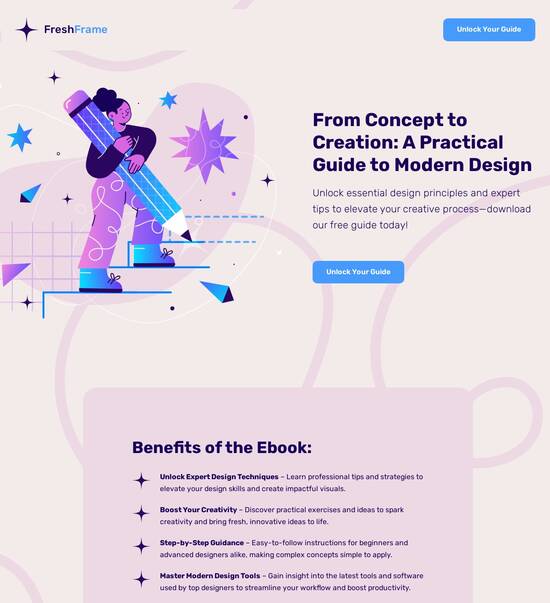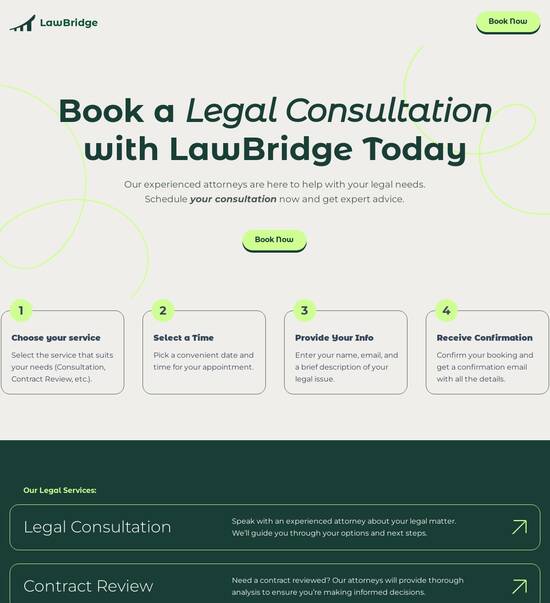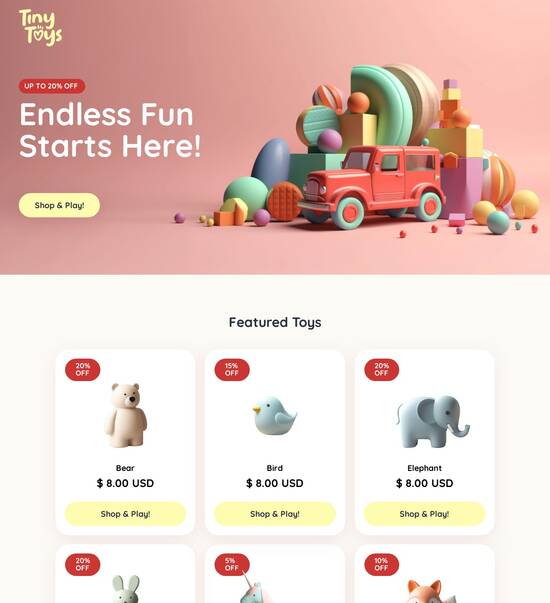
React.js optimized get started page template
Explore Similar TemplatesAbout template
Supercharge your get started page with React.js for outstanding performance! Learn more today.
Recommended templates
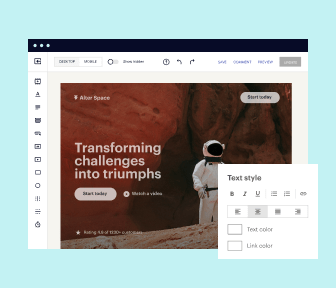
Easy to build without coding
With the intuitive drag-and-drop builder, anyone on your team can create high-converting pages without any knowledge of code or design. Make enhancements to your landing page with custom widgets using Javascript, HTML/CSS, or third-party scripts.
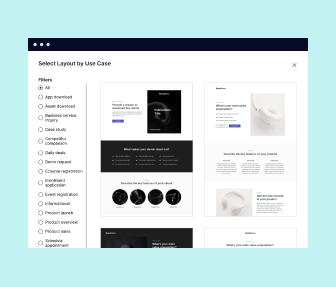
Multiple layouts for any industry and goal
Select from 500+ landing page layouts built to boost conversions across industry-specific scenarios. Customize them by adjusting fonts, adding images, and generating on-brand content with the AI assistant. Quickly scale with Instablocks® and Global Blocks that you can save, reuse, and update globally.
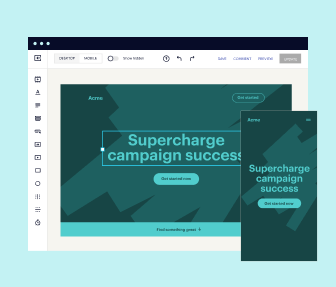
Loads fast and looks polished on any device
Every template is responsive, which means they present professionally on any device and load blazingly fast with our Thor Render Engine. You can also power them up with Google AMP technology to deliver an unparalleled mobile experience and drive higher conversions.
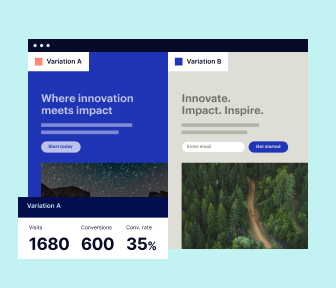
Robust analytics & experimentation
Get real-time updates and reporting across all your devices, showing the number of visitors, conversions, cost-per-visitor, and cost-per-lead. Launch AI-powered experiments, run A/B tests, and use heatmaps to analyze user behavior, then optimize your landing page to maximize conversions.
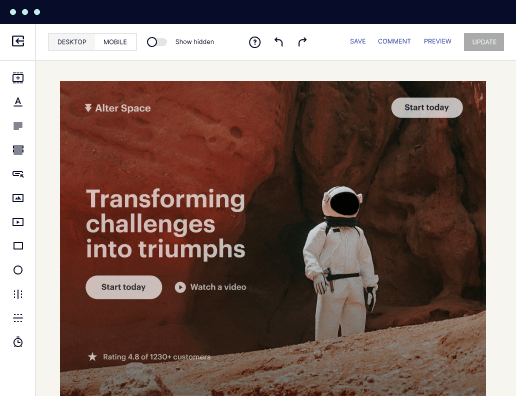
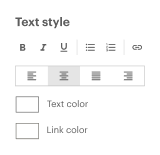
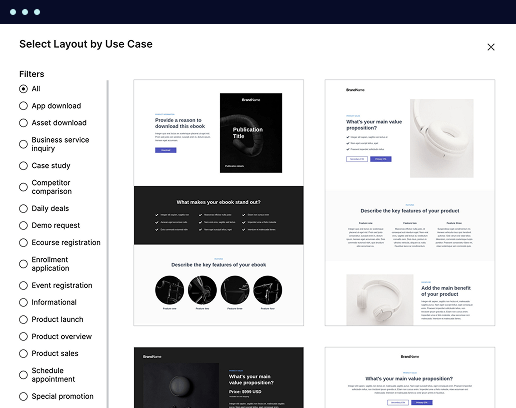
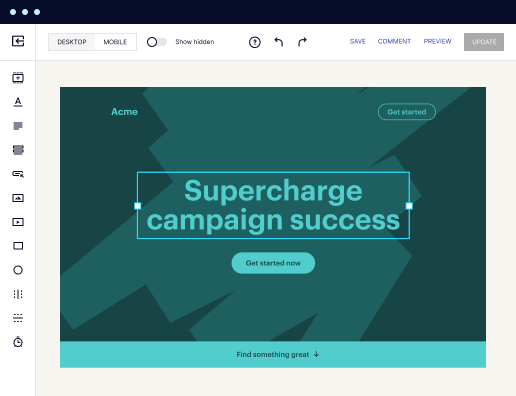
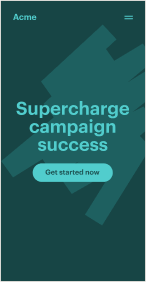
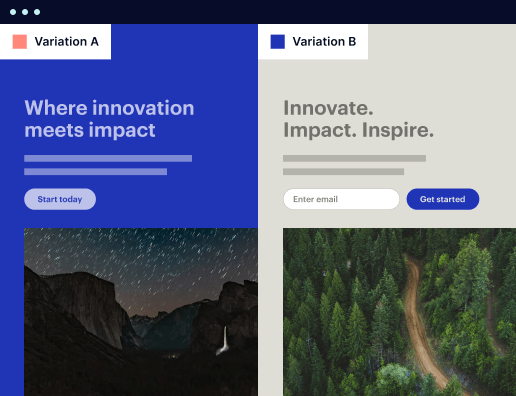
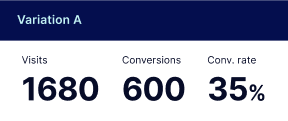
Easy to build without coding
With the intuitive drag-and-drop builder, anyone on your team can create high-converting pages without any knowledge of code or design. Make enhancements to your landing page with custom widgets using Javascript, HTML/CSS, or third-party scripts.
Multiple layouts for any industry and goal
Select from 500+ landing page layouts built to boost conversions across industry-specific scenarios. Customize them by adjusting fonts, adding images, and generating on-brand content with the AI assistant. Quickly scale with Instablocks® and Global Blocks that you can save, reuse, and update globally.
Loads fast and looks polished on any device
Every template is responsive, which means they present professionally on any device and load blazingly fast with our Thor Render Engine.
Robust analytics & experimentation
Get real-time updates and reporting across all your devices, showing the number of visitors, conversions, cost-per-visitor, and cost-per-lead. Launch AI-powered experiments, run A/B tests, and use heatmaps to analyze user behavior, then optimize your landing page to maximize conversions.
All the features you need to build lead-generating landing pages
Explore more featuresLearn how to build top-performing landing pages for any goal
FAQs
Leading the way in building high-performing landing pages





A powerful landing page optimization guide with Instapage
Effective landing page optimization is crucial for maximizing the ROI of your digital marketing campaigns. Instapage offers comprehensive tools and a user-friendly platform that empower marketers to accelerate their efforts in creating high-converting landing pages without the need for coding expertise. With over 100 templates and lead generation elements available, marketers can quickly launch pages that attract and convert visitors.
Getting started with Instapage for landing page success
To effectively utilize Instapage, begin by familiarizing yourself with its intuitive interface. You can easily browse through various conversion-focused layouts and Instablocks, which allow for a flexible approach to creating tailored landing pages. Opting for an all-in-one solution enables marketers to streamline their workflow while enhancing the creative process.
- Explore the 100+ ready-to-use templates: Choose from a vast repository of designs that cater to various industries.
- Utilize lead generation elements: Instapage incorporates tools like forms and CTAs that are essential for capturing leads effectively.
- Leverage collaboration features: Improve production time by providing real-time feedback and edits on the pages.
Step 1: Choose the right template
Picking the correct template is crucial for ensuring your landing page resonates with your target audience. Instapage’s library provides templates designed to cater specifically to industries such as education, finance, and technology, which can engage visitors more effectively.
Step 2: Optimize for performance
Once your template is selected, focus on optimizing the elements for performance. Use conversion analytics to identify opportunities for improvement:
- Conduct A/B testing: Experiment with different headlines, images, and CTAs to identify what performs best.
- Analyze heatmaps: Understand user behavior and focus on areas where visitors are engaging or dropping off.
- Implement personalization: Use dynamic text replacement to tailor the page content directly to the visitor's needs.
Step 3: Launch and measure results
After finalizing the optimizations, proceed to launch the landing page. It’s crucial to measure the page’s performance metrics consistently:
- Track conversion rates: Monitor the effectiveness of the changes made compared to previous versions of the page.
- Review qualitative feedback: Use user surveys to gather insights on user experiences and areas for enhancement.
- Make data-driven adjustments: Regularly refine your landing pages based on analytical findings.
By following these steps and utilizing Instapage’s powerful features, marketers can significantly enhance the effectiveness of their landing pages.
Don't miss out on the opportunity to optimize your digital marketing campaigns. Start using Instapage today and transform the way you engage with your audience!
People also ask about React.js optimized get started page template
ReactJS optimized get started page template
Understanding the power of ReactJS in web development
ReactJS has gained immense popularity within the web development community due to its flexibility and efficiency. Known for its ability to create single-page applications, ReactJS allows developers to build user interfaces in a streamlined and effective manner. One of its key features is the component-based architecture, which promotes code reusability and modularity. Each part of a website can function independently, making it easier to maintain and update without affecting the entire application.
Optimized templates play an essential role in leveraging ReactJS to enhance web performance and create engaging user experiences. By providing a structured layout, optimized templates can facilitate rapid initial loading times and improve responsiveness. This is especially significant when it comes to user onboarding, where the initial interactions can significantly influence user retention rates.
The need for a get started page in any application
A well-designed Get Started page serves as the first point of contact for users engaging with your application. The purpose of this page is not just informational; it is critical for user onboarding and ensuring that new users understand how to navigate your application effectively. Providing clear guidance and welcoming content creates a positive first impression that can greatly enhance user engagement and retention.
However, crafting an effective Get Started page presents unique challenges. Many developers struggle with ensuring easy navigation, and users can easily feel overwhelmed if the layout is too complex. If a user cannot find their way or grasp the app's primary functions quickly, it may lead to frustration and potentially drive them away from the application altogether. Therefore, understanding user expectations and reducing friction is paramount.
Elements of an optimized get started page template
An effective Get Started page template comprises several key components designed to enhance user experience. These elements generally include user-centric design features that prioritize simplicity and clarity. For instance, using straightforward navigation systems ensures that users can easily find their way around the app. Additionally, clear call-to-action segments guide users on what they should do next, reducing confusion during their initial interactions.
Essential content components are also crucial. The page should provide an introduction to the app's purpose, clearly outlining its benefits and functionalities. Supplementing this with step-by-step guides or tutorials can further aid users in understanding how to utilize the application effectively. Moreover, incorporating multimedia elements such as engaging visuals or interactive tutorials enhances the overall experience. These enhancements not only hold user attention but promote deeper engagement with the content.
User-centric design elements like simple navigation systems.
Clear call-to-action segments to guide user interaction.
Essential content such as purpose introductions and step-by-step guides.
Incorporation of multimedia elements like interactive tutorials and engaging visuals.
From a technological perspective, leveraging libraries and frameworks can significantly enhance the performance of your Get Started page. For instance, using React Router for seamless navigation can help in creating a smooth user experience. Additionally, employing state management solutions like Redux or the Context API ensures consistency in how your application manages data across various components. Frontend styling can also benefit from CSS frameworks such as Tailwind or styled-components, allowing for quick yet aesthetically pleasing designs.
Architecting your ReactJS get started page template
A well-organized structure is foundational for building an effective ReactJS application. It begins with determining the directory layout for your project. Organizing files into distinct folders such as components, assets, and styles can improve maintainability and facilitate collaborative development. This way, developers can quickly locate specific pages or components, tracking changes efficiently without navigating a chaotic structure.
After structuring the project directory, the next step involves constructing the individual page components. A standard Get Started page layout typically includes a header and navigation section that prominently displays the app's branding and primary links. The main content area is where users will find step-by-step guides and additional resources to ease their onboarding process. It’s also beneficial to include a dynamic FAQs component that evolves in response to user input, fostering engagement and directly addressing user queries.
Furthermore, optimizing performance is crucial for a responsive user experience. Implementing code-splitting using React.lazy and Suspense allows for faster loading times by reducing the amount of code that needs to load when the component first renders. Additionally, images should employ lazy-loading techniques where images are only loaded when they enter the viewport, enhancing overall page speed and performance.
User engagement strategies
Fostering user engagement on the Get Started page can significantly enhance user experiences and retention. One effective strategy is integrating community engagement features. By adding forums, discussion boards, or even in-app chat functionalities, users can connect and share experiences, fostering a sense of community. This collective knowledge can serve as a resource for newcomers, helping them feel more comfortable and confident in using the application.
Moreover, gathering user feedback is vital for continuous improvement. Implementing feedback forms or surveys can yield valuable insights into user experiences and expectations. Analyzing the collected data helps developers make informed decisions about enhancements or changes that can improve usability. Another effective means of enhancing the page is by integrating external links to valuable resources such as documentation, tutorials, or video walkthroughs created by community members. These links can significantly aid new users in understanding the application more clearly and effectively.
Evaluation and enhancement
Regularly evaluating the performance of your Get Started page is necessary to ensure its effectiveness. Metrics such as user engagement and retention statistics provide insight into how well the page performs in onboarding new users. For instance, tracking the drop-off rates can highlight potential issues when users interact with the Get Started page. Understanding why users leave can inform future optimizations and design changes.
Iterative improvement should be a fundamental part of the development process. Gathering insights from user feedback forms a foundation for making enhancements. A/B testing different layouts or content formats allows developers to assess which variations yield better engagement and user retention. By continuously analyzing these metrics and user feedback, adjustments can be made to craft an engaging and effective Get Started page.
Future-proofing your get started page
Staying ahead in the rapidly evolving landscape of web development requires keeping up with advancements in ReactJS practices. Regularly checking community forums and official documentation can reveal new features or best practices that could enhance your Get Started page's functionality. Continuous learning through tutorials and online courses will empower developers to implement innovative ideas and ensure their applications remain competitive.
Monitoring trends in user preferences is another essential component for future-proofing your application. As technology and user experiences change, your Get Started page should adapt accordingly. Assessing components based on user demographics and behaviors can uncover opportunities for enhancing personalization. By understanding the unique contexts in which users interact with your application, developers can fine-tune the Get Started page to suit various audience needs.
Real-world examples and case studies
Examining successful Get Started pages across various applications can provide invaluable insights into effective strategies and design elements. Top-performing apps often share similar traits, such as concise and engaging introductions and straightforward navigation features. Analyzing these examples enables developers to identify best practices and learn from methods that have excelled in attracting and retaining users.
Moreover, highlighting unique implementations of ReactJS features in these case studies shows creative approaches to building user-friendly interfaces. Investigating how different apps tackle user onboarding and engagement can inspire new ideas for developers looking to optimize their Get Started pages. A diverse array of approaches, from minimalist designs to robust interactive guides, will showcase the flexibility that ReactJS offers to tailor experiences to users.
Building a community around your template
A strong community involvement can greatly enhance the development of your ReactJS Get Started page template. Development teams can collaborate and enhance functionality by sharing ideas and implementing user feedback. Engaging users supports a sense of ownership and can inspire them to contribute positively to the community, ultimately driving user satisfaction and retention.
Encouraging open-source contributions can also catalyze innovation. When developers share their enhancements, they promote a cycle of continuous improvement and knowledge sharing. Creating a shared knowledge base through community collaboration not only optimizes the Get Started experience but also fosters a community that is knowledgeable and invested in improving the application further.
Final thoughts on optimizing ReactJS get started pages
Utilizing optimized templates for Get Started pages holds significant advantages in enhancing user experiences. A well-thought-out design not only attracts users but also facilitates their understanding of how to navigate your application effectively. Implementing strategies for evaluation, user engagement, and community building will contribute to continuous improvement and innovation in your template.
As technology evolves, so should your approach to building engaging Get Started pages within ReactJS applications. By remaining adaptable and open to new ideas, developers can create experiences that not only meet user needs but also foster long-term customer loyalty and satisfaction.
Ready to skyrocket conversions?
Supercharge your ad campaigns with high-performing landing pages
Get started